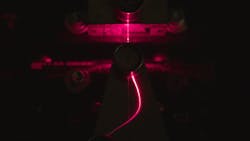VTT develops cellulose optical fiber for sensing applications
Researchers at VTT Technical Research Centre of Finland (Espoo, Finland) have created a wood-based optical fiber that transmits light in the 500 to 1300 nm spectral range, with an attenuation of 6.3 dB/cm at 1300 nm.1 Optical fiber made of cellulose is best-suited for sensors that benefit from the biodegradability of the material, say the researchers. In the future, optical cellulose fiber may allow detecting changes in the moisture level of buildings.
The core of the fiber is cellulose modified for the purpose using ionic solvents developed by VTT; around the core is a cladding made of cellulose acetate. "The R&D is still in its initial phases, so we do not yet know all the applications the new optical fiber could lend itself to," says VTT senior scientist Hannes Orelma.
Cellulose has properties making it suited for use in optical-fiber sensors: The material used in cellulose fibers can in itself react with the substances being measured and absorb them, which is difficult for glass or plastic fibers. Cellulose is also easy to modify in regards to, for instance, the index of refraction. Cellulose effectively absorbs and releases water, which can be measured by the change in the attenuation of light transmitted in the fiber. In addition, cellulose is biodegradable, and the fiber used for the sensor can be disposed of with biowaste.
Cellulose-based fiber opens up new opportunities for sensor applications, but it will not compete with glass-based optical fibers in telecommunications applications.
The development of the optical fiber began in VTT’s iBex program, which allows the researchers involved to implement interesting solutions to global challenges. Currently, this R&D is continuing in the FinnCERES flagship program in collaboration with VTT and Aalto University.
Source: VTT
REFERENCE:
1. Orelma, H. et al., Cellulose (2019); https://link.springer.com/article/10.1007/s10570-019-02882-3.

John Wallace | Senior Technical Editor (1998-2022)
John Wallace was with Laser Focus World for nearly 25 years, retiring in late June 2022. He obtained a bachelor's degree in mechanical engineering and physics at Rutgers University and a master's in optical engineering at the University of Rochester. Before becoming an editor, John worked as an engineer at RCA, Exxon, Eastman Kodak, and GCA Corporation.
